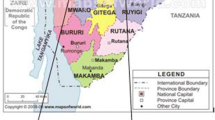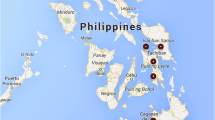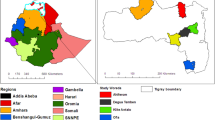Abstract
A decentralized seedling production is regarded as the most effective means of providing smallholders with planting materials. However, the sustainability of smallholder nursery operation is constrained by several factors, including the limited availability of germplasm, lack of technical skills and low seedling demand low viability of seedling market. The government nursery sector could complement the weaknesses of the smallholder nursery group but government nurseries are not operating effectively to enhance the availability of high quality seedlings of a wide species base for smallholder forestry. Seedling production in government nurseries is quantity-orientated with low emphasis on the production of high quality planting materials. Germplasm used in seedling production is mostly collected from unselected sources and seedlings produced are mostly of low physical quality. The species selection in government nurseries is heavily based on the availability of germplasm which resulted in the production of a few species which are commonly raised on private nurseries. The duplication of species of most seedlings raised in government nurseries with those produced in private nurseries and the far distance of government nurseries from the villages has resulted in low uptake of seedlings by smallholder tree farmers. For the government nursery sector to become more effective in providing support in the present paradigm of decentralized seeding production, a change from its production system and a broadening of the role it plays is needed. The social mobilization on seedling production as a scheme of implementing the Green Philippines Program has led the Department of Environment and Natural Resources to acknowledge the seedling production activity of private individual and communal nursery groups. This can be an opportunity for organizing the private and government nursery sectors to promote the operational effectiveness of the overall forest nursery industry.
Similar content being viewed by others
Notes
Germplasm refers to wildlings and plant parts including seeds, leaves and branches used to produce a new planting material.
Sturdiness quotient is the ratio of the height of the seedling to the root collar diameter, which expresses the vigour and robustness of the seedling. The ideal value for a seedling to be considered sturdy is less than six (Jaenicke 1999).
Root-shoot ratio refers to the proportion of the root dry-weight to the shoot dry-weight. A root-shoot ratio between one and two is considered as optimal (Jaenicke 1999).
All in-charge of government nurseries have attended training sessions about nursery seedling production and completed four-year tertiary education.
References
Barnard G, Foley G (1984) Farm and community forestry. Technical Report No. 3, Earthscan, London
Carter J (1987) From Seed to Trial Establishment: a Handbook Giving Practical Guidelines in Nursery Practice and the Establishment of Simple Species and/or Provenance Trials, DFR User Series No. 2, Australian Tree Seed Centre, CSIRO Division of Forest Research, Canberra
Cedamon ED, Emtage NF (2005) ‘Present tree planting and management activities in four rural communities in Leyte Province’, In: Harrison SR, Herbohn JL, Suh J, Mangaoang E, Vanclay J (eds) ACIAR Smallholder Forestry Project—Redevelopment of a Timber Industry Following Extensive Land Clearing: Proceedings from the End-of-Project Workshop, 19–21 August, 2004, Ormoc City, the Philippines, pp 37–50
Emtage N (2004) An Investigation of the Social and Economic Factors Affecting the Development of Small-scale Forestry in Leyte Province, the Philippines, PhD thesis, School of Natural and Rural Systems Management, The University of Queensland, Brisbane
Estoria E (2004) An Investigation of the Factors Affecting the Success of Community Organizations, Masters thesis, School of Natural and Rural Systems Management, The University of Queensland, Brisbane
Evans J, Turnbull J (2004) Plantation forestry in the tropics: the role, silviculture and use of planted forest for industrial, social, environmental and agroforestry purposes, 3rd edn. Oxford University Press, Oxford
Gregorio NO (2006) Improving the Effectiveness of the Forest nursery Industry in Leyte province, the Philippines, PhD thesis, School of Natural and rural Systems Management, The University of Queensland, Gatton
Gregorio NO, Herbohn J, Harrison S (2007) ‘The operational effectiveness of the forest nursery sector in Leyte, Philippines’. In: Harrison SR, Bosch A, Herbohn JL (eds) Improving the Triple Bottom Line Returns from Small-scale Forestry, Proceedings from an international Conference held in Ormoc, the Philippines, 18–21 June 2007, Brisbane
Jaenicke H (1999) Good tree nursery practices: practical guidelines for research nurseries. ICRAF, Nairobi, pp 8–15
Jones N (2004) Essentials of good planting stock. In: Elevitch C (ed) The overstory book: cultivating connections with trees, 2nd edn. Permanent Agriculture Resources, Holualoa, Hawaii
Mulawarman RJM, Sasongko SM, Irianto D (2003) Tree seed management, seed sources, seed collection and seed handling: a field manual for field workers and farmers, International Centre for Research in Agroforestry (ICRAF) and Winrock International, Bogor, Indonesia
Robinson R, Thompson I (1987) Fodder trees, nurseries and their central role in the hill farming systems of nepal. social forestry network. Rural Forestry Development Network, Overseas Development Institute (ODI), London, p 11
Shanks E (1992) Networking in action: forestry extension materials in review, Rural Development Forestry Paper 14 a, Winter 1992, ODI, London
Shanks E, Carter J (eds) (1994) The organization of small-scale tree nurseries: studies from Asia, Africa and Latin America. Rural Development Forestry Study Guide 1. Rural Development Forestry Network, Overseas Development Institute, London
Sy M (2001), ‘A cursory look of reforestation in the Philippines’, Canopy international, January–February, pp 6, 11
Wightmann K (1999) Good tree nursery practices: practical guidelines for community nurseries, International Centre for Research in Agroforestry, Nairobi, Kenya
Author information
Authors and Affiliations
Corresponding author
Rights and permissions
About this article
Cite this article
Gregorio, N.O., Harrison, S. & Herbohn, J. Enhancing Tree Seedling Supply to Smallholders in Leyte Province, Philippines: An Evaluation of the Production System of Government Nursery Sector and Support to Smallholder Tree Farmers. Small-scale Forestry 7, 245–261 (2008). https://doi.org/10.1007/s11842-008-9053-3
Received:
Accepted:
Published:
Issue Date:
DOI: https://doi.org/10.1007/s11842-008-9053-3




